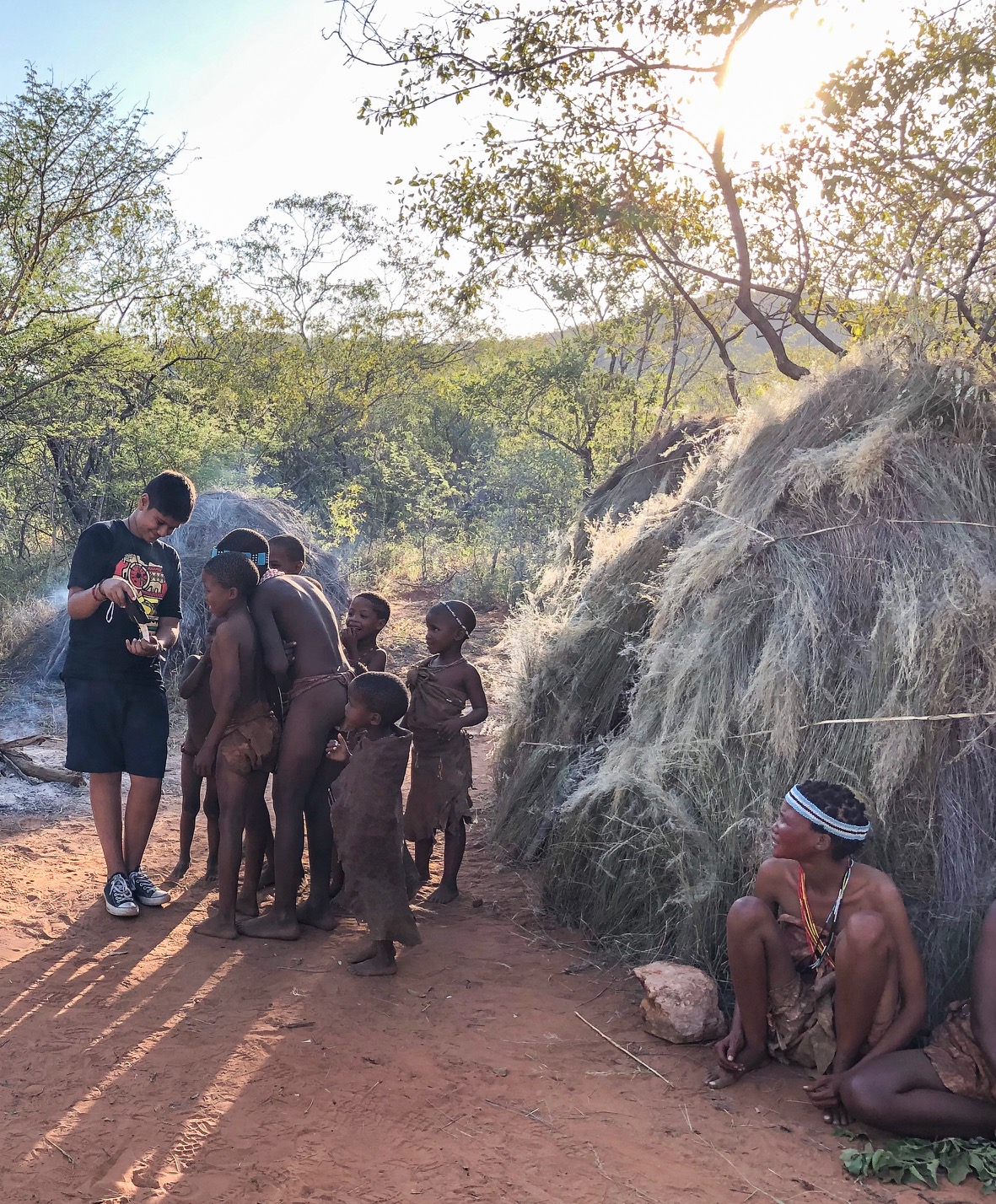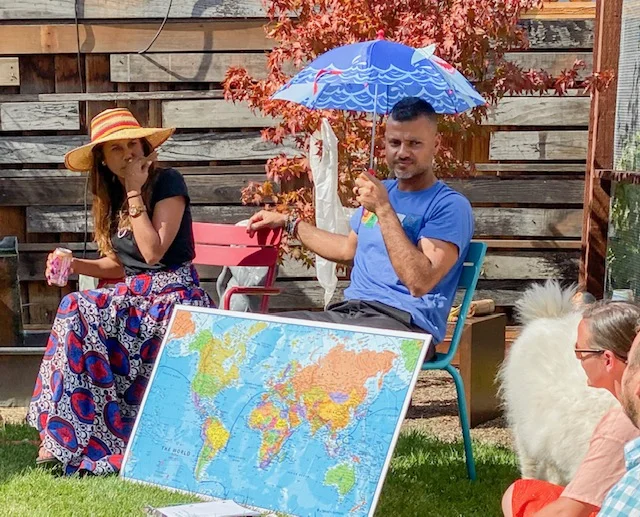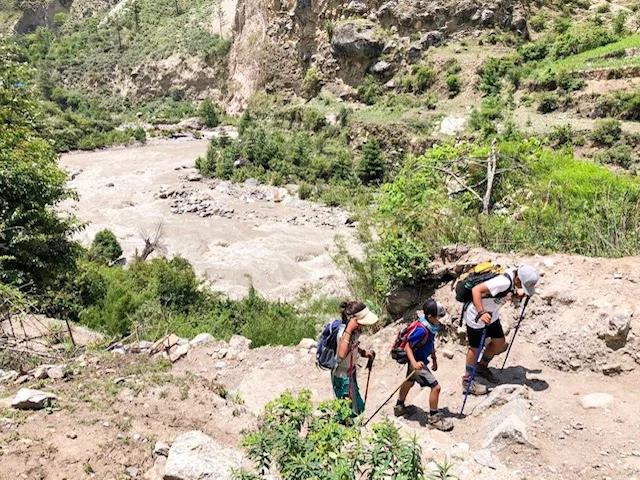Botswana and the KhoiSan: Thank you to Kevin Costner, Polaroid, and Victoria Falls
This is the second post of a 4-part series on our experience in the remote Kalahari Desert of Botswana with the “Bushmen” or KhoiSan people from the Ju!Hoansi Tribe back in April 2019. See our Instagram Story Highlights Botswana here for quick videos, though a longer video will be created in the next several weeks and shown on our YouTube Channel (please subscribe here). Our website is the best place to sign-up for email updates of new posts! Thank you for sharing in this adventure.
—-
Cover Photo: Kenza connecting with the kids through dirt art.
Given that we solidified our Botswana plans during our quick movement through North Africa and the Middle East, we didn’t do much in the way of preparing the kids for our time with the KhoiSan. But when we finally had some down time, in Kenya, we took a look at one of the video links that was sent to us as background information. The video got me and Kapil super excited to learn from this culture, but it also made me realize that we would need to address the issue of nudity with the kids.
Throughout this trip, we have been in various contexts and have immersed ourselves in different cultures, from the Guajeros who live on the border of the trash dump and Uros of Lake Titicaca’s floating islands, to refugees in Palestine, the Maasai of Tanzania, and many more. An through their exposure to many different cultures, cuisines, and living environments, the kids have always been respectful and kind during the moments spent with others, even if they had lots of follow-up questions for us later.
Just after our trip to Rapa Nui (Easter Island), I showed them Kevin Costner’s B-grade movie about the Birdman competition, as a part of “school.” time. The movie was rated “R” for nudity because of the topless clothing worn (or not worn, I should say) by the Rapa Nui women at that time. The kids had never seen an “R” movie and they were more shocked that I allowed this movie into “school” than of the actual nudity. Nonetheless, Kaysee had his fair share of “booby” comments during the first few minutes of the movie. Other than this movie, which is still a story they love to tell, about “the time Mommy let us watch an “R” movie with a bad plot and boobies because she thought it was educational,” the kids have not seen, much less interacted with, cultures who live mostly in the nude…well come to think of it, neither have I.
The kids had heard of the “Bushmen” as one of the indigenous cultures still living the traditional way when we were traveling in Tanzania, and they were excited to learn how they hunt and live off of the land. But that was all they knew of the “Bushmen” and they thought they’d save their questions and learning for when they were actually living with them. So, before one dinner in Kenya, Kapil and I pulled Zayan and Kenza aside individually to give them the heads up that the “Bushmen” clothing might be sparse, and we would need their leadership in helping Kaysee process so that he doesn’t make an awkward comment when we actually visit them. They agreed and were clearly happy to be part of “Operation: Keep Kaysee Calm.”
Over dinner, we talked about how different cultures wear different clothing and that much of the clothing styles we see today, originated from colonization hundreds of years ago—a concept that we have been discussing along with slavery since the beginning of the trip in Belize and most heavily in South America. I showed them some of the video so that they could see the clothing and get their shock out of the way. To my surprise the conversation veered towards climates and how clothing/lack of clothing was a function of where people lived. Our privilege showed in the sensitivity we anticipated needing for this conversation, but the kids checked it by elevating the conversation beyond “how people dress” to why indigenous dress had been abandoned. I’m crediting the Rapa Nui movie on this one—thanks Kevin!
Polaroid Technology Busts the Ice
Visiting with the Ju!Hoansi for the first time was intimidating for everyone. Together with the Ju!Hoansi, we were a large group of about 36 people. Our kids were quiet and didn’t quite know what to do or say, and it was the same situation for the Ju!Hoansi kids. Appropriately authentic, the meeting was unstructured, and nobody quite knew how to break the ice. This wasn’t the first time that we’ve been in this situation, but it felt more like an experience back home than on our trip, which has been mostly immersions in smaller groups of people. Back home, a seasonal cold-weather homeless family shelter had opened near our home and we brought dinner and spent hours just hanging out with people. The kids wanted to be at that shelter and they wanted to connect, but they didn’t want to do the wrong thing and offend anyone, nor did they know how to interact with kids their age who were in a very different circumstance than they were. I don’t mean to liken the Ju!Hoansi to the unhoused, but rather the experiences of not knowing how to “be” in an environment that feels so different to their own, without an activity to anchor them and break the ice.
To help the initial interactions, we used a tool, that has brought joy to so many…a camera. We brought a small Polaroid camera on this trip so that we can take pictures of others for them! They get to have a picture of themselves instantaneously. We have been in so many settings (i.e. in the Amazon Jungle, in the highlands of Peru, the obscure villages of the Middle East) where the folks may have seen a smart phone, but never an instant camera. I had Zayan ask if any of the kids would like their picture taken, and they all got excited. In fact, many of the adults in the group wanted one too! We started a mini-photo session which began to chip away at the ice.
Zayan showing the group of kids the Polaroid camera…and you can see the interest peaked in the adult woman pictured here on the right!
Cultural Imagery
Speaking of ice-breaking, over the three days, we got closer and less effort was needed in this regard. Yet, as I reflect on how we built relationships with each other, several interactions come to mind. One was drawing with the kids.
On one of the occasions when we were just hanging out in the nomadic bush village with the Ju!Honansi, Kenza was next to me and just needed an “in” with the girls; so I assisted by doing something that would play to her strengths—drawing. I started drawing a tree and then said “tree” in English, while they said the word in Ju!Hoansi. Because my artistic repertoire is limited, I went to my next usual drawing in the traditional “front yard scene,” a house. Only after drawing the square, I realized that their hut looked completely different. I erased the drawing and was about to draw a dog or cat, and then again, I realized that a “pet” was a bit out of context. I drew a blank. Luckily, amidst my brain lapse, I caught sight of the village fire. I drew a fire and was back on track. I handed my drawing stick to Kenza and reminded her to keep her drawings to natural elements. Phew! I was off the hot seat and the kids drew and drew over the next two days.
Kenza beginning to draw in the dirt with the kids in a non-intrusive way. The other (9-year-old) girl, Thwee, drawing on the right would later become Kenza’s friend.
Wonderment
One of the days where we were all just chatting in a circle with Kavaa translating, we told the group more about ourselves. As Kapil and I were telling them that we have been traveling around the world for the last 10 months, it occurred to me that many of them did not know the names of the countries we had been to. They hadn’t understood what Antarctica was. I reached for my phone and showed them some pictures, but they had never experienced snow and ice! Once again, I was reliving the moment I had experienced in drawing with the kids, only now, instead of the “ah-ha” moment popping into my head during silent drawing, it was happening sentence after sentence! Oh no! This was supposed to be an ice-breaker, not and ice-builder!
I took a page from my last lesson-learned and switched to talking about the elements that we both knew and luckily, our family had just been to Victoria Falls. I played a video of the powerful falls and they were mesmerized. They started exclaiming “Yooow” (like “woah” in English) and talking/clicking very quickly as they passed the phone around the circle to play the video over and over again. They were shocked and had never seen so much water before! It was a beautiful experience to see the true wonderment in their eyes as they watched the video. It was a moment I know all of us will remember, for different reasons.
Two of our favorites, Kgao Qam and Kgamxoo Tixhao (pronounced, K’au Kum and K’um Ko, respectively), the older guys of the group, who are affectionately called “the old boys” by Kavaa and Rob, had been (of all places) to New York. They were invited to a gathering of indigenous wise-people from around the world. They were to spend a few days discussing the ways they heal people and observe both the commonalities and differences from other guests, and Kavaa was both an escort and translator for the old boys. We were fascinated to hear about their perceptions of New York. They said it was very cold and there were lots of cars, but they really liked it. Kava told us that while in New York, everywhere they turned they told each other, “wow, that is the tallest building we’ve ever seen” and then they would turn again and say, “Oh! No, that is the tallest!”
The only negative thing that they shared was that they hated the “moving stairs” and found that very stressful. Kavaa told us that after one experience on the escalator, they only took elevators. It must have been so cute (and as Kava tells it, amusing) to watch their excitement as they discovered New York. It must have been the “Victoria Falls moment” times 10,000!
I was trying to describe something here—perhaps Victoria Falls. We used a lot of hand gestures when talking so that the group could follow along ahead of translation.
The old boys. We would soon find out that Kgao Qam on the far left and Kgamxoo Tixhao on the far right were the most experienced trance healers in the group. Here they were reading the sticks to determine the best direction to go into the Bush for hunting/gathering.

























